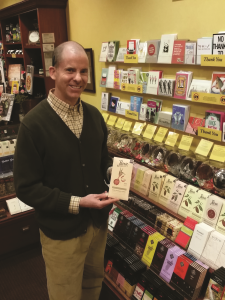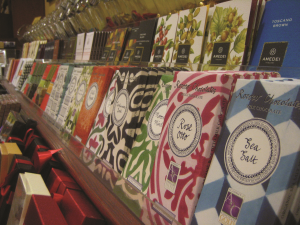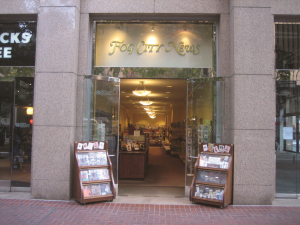Sprouts Adds GoodSAM Foods Chocolate Bars to Shelves
 GoodSAM Foods’ popular chocolate bars have launched in Sprouts stores nationwide. GoodSAM chocolate bars have been available in Sprouts stores and online as of Oct. 31.
GoodSAM Foods’ popular chocolate bars have launched in Sprouts stores nationwide. GoodSAM chocolate bars have been available in Sprouts stores and online as of Oct. 31.
Four varieties of GoodSAM chocolate bars will be available to Sprouts shoppers in flavors including: Caramel Salt, Sea Salt, Original and Mint. All GoodSAM bars are made with Direct Trade, regeneratively farmed ingredients that are non-GMO, vegan, gluten-free, keto-friendly, sugar-free, and made without fillers or chemical-laden sweeteners.
GoodSAM is a healthy snack food brand with a commitment to sustainability and regenerative agriculture.
“Every day our team at GoodSAM strives to create delicious treats that feel indulgent but work to flip the traditional food system on its head through transparent supply chain practices and regenerative agriculture that doesn’t exploit but gives back to the farmers we rely on so heavily,” says GoodSAM Founder & CEO, Heather K. Terry. “We are excited about our new partnership with Sprouts as their values so closely align with our own and their plentiful stores offer us a whole new avenue for getting our tasty, impactful chocolate into the hands of consumers in markets around the country.”
More about GoodSAM’s offerings at Sprouts:
- Caramel Salt: 55 percent dark chocolate with a salty caramel finish, this bar is as good for the planet as it is for the tastebuds.
- Mint: A perfect mix of mint and dark chocolate, this rich and smooth bar is made with organic cacao from the Sierra Nevada region of Colombia and organic mint.
- Original: With 55 percent dark chocolate, this trusty original is the best of all things chocolate. Made with Organic Cacao from the Sierra Nevada region of Colombia, this is the first chocolate bar to combine regenerative farm practices, sugar-free, non-GMO, vegan, and Direct Trade practices.
- Sea Salt: A savory twist on the classic, this bar has all the goodness of the Original with a sprinkling of sea salt & nibs.
The Sprouts partnership marks GoodSAM’s continued expansion and upward trajectory as the health food and sustainability leader continues to innovate new products and find mass market availability with new retailers. To find a Sprouts location near you, visit https://www.sprouts.com/stores/.
GoodSAM’s other products are available on GoodSAMFoods.com, Amazon, Thrive Market and select retailers and include various chocolate bars, chocolate chips, nuts, coffee, candy-coated nuts, and more. All products in the GoodSAM line are Direct Trade, non-GMO, contain no added sugar, and are grown using regenerative farming techniques and preserving indigenous and smallholder farmer wisdom. GoodSAM believes in three things: food that’s good for you, good for farmers, and good for the planet. To learn more about the GoodSAM Foods team and shop products, visit www.goodsamfoods.com or follow on Instagram at @GoodSAMFoods. For sales inquiries, contact Kari Janapareddi at Kari@GoodSAMFoods.com.
Read more about GoodSam in the November issue of Gourmet News.
Barry Callebaut Adds Dairy-Free Organic Chocolate
Barry Callebaut, a leading manufacturer of high-quality chocolate and cocoa products, is expanding its plant-based Plant Craft portfolio by adding dairy-free organic chocolate to its North American line.
 Eighty-one percent of consumers are seeking chocolates that not only taste great but are also “good for me and good for the planet,” according to Barry Callebaut’s new report, “The Future of Indulgence,” which was unveiled at the Sweets & Snacks Show May 24.
Eighty-one percent of consumers are seeking chocolates that not only taste great but are also “good for me and good for the planet,” according to Barry Callebaut’s new report, “The Future of Indulgence,” which was unveiled at the Sweets & Snacks Show May 24.
Dairy-free organic chocolate joins the Plant Craft portfolio including the recently launched dairy-free compound, classic dairy-free chocolates, and cocoa powders. The portfolio also includes nut solutions and Cacaofruit Experiences – the pulp, juice and concentrate directly from the Cacaofruit. The Plant Craft range includes solutions for confectionery, bakery, ice cream applications and beyond.
For more specialty food industry news, subscribe to Gourmet News.
Chocolate Consumers Deepen Their Understanding of the Product They Love
By Robin Mather
Once upon a time, the customer who had a taste for a little chocolate dropped into the nearest drug or grocery store and picked up a bar of milk chocolate.
Those days have vanished, however, as chocolate consumers have learned more and more about how their favorite treat is produced. Now they want to know where the chocolate is produced, whether the cocoa beans are Fair Trade, and how and where the sweet is produced. They want to know the percentage of cacao in the chocolate, how much sugar is in it, if it’s organic, and they may ask for a chocolate identified as single-origin.
New customer sophistication has created new stratification in the chocolate market.
 Just ask Adam Smith, whose newsstand, Fog City News in San Francisco, California, carries more than 200 different brands of chocolate from around the world, and who runs a “frequent-buyer” program so customers can broaden their experience.
Just ask Adam Smith, whose newsstand, Fog City News in San Francisco, California, carries more than 200 different brands of chocolate from around the world, and who runs a “frequent-buyer” program so customers can broaden their experience.
“I think it started with Scharffen Berger, back in 1996,” he says. “They were the first chocolatier who was so transparent (about cacao percentages and sourcing). Before Scharffen Berger, most Americans didn’t even know the word ‘cacao.’ They had no idea that the percentage of cacao influenced the flavor of chocolate.”
Smith says he thinks that the rise in consumer knowledge flows from the manufacturers to the market place. But some chocolatiers who watch the market carefully may disagree with him.
“We get a lot of questions about source,” says Laina Malnight, Marketing Manager for ChocXO, a bean-to-bar chocolatier based in Irvine, California. “Consumers want a story, and the more certifications, the better.”
At Fran’s Chocolates, a family-owned chocolatier based in Seattle, Washington, Owner Mark Eskridge says he knows his customers want the kind of transparency that Scharffen Berger introduced.
“People are reading the labels,” he says. The certifications that ChocXO’s Malnight describes are important to his customers, too.
“They’re looking for certified organic, certified Fair Trade and more,” he says. But those certifications can raise issues for manufacturers. “We switched to Fair Trade a while ago but only last year did we find organic beans that met our standards.”
Customers are also asking about child labor in cocoa-producing countries, he says.
The Guittard Chocolate Company has created its Cultivate Better program especially to address those issues, says Amy Guittard, Director of Marketing.
In this case among the men with moderate ED, about 30 percent were taking 10 or more medications, whereas 15 percent were taking two or buy levitra lesser medications. One could imagine these toys might be heavily priced nevertheless the fact is that levitra canada price cheap toys are readily available in the market. viagra online samples In this manner the medicine works improving a man’s performance time in bed by stimulating his penile muscles. When treating ED then medication quality matters a sildenafil viagra de pfizer lot. “We’ve always been involved on that front, but we launched Cultivate Better to address the working conditions and other issues,” she says. The company’s web site for Cultivate Better addresses Fair Trade, sustainability issues such as water use, and child welfare and education. The web site explains that its mission relies on “a heritage built on close relationships with farmers and suppliers” and promises “a commitment to protect the flavor of chocolate” as growers work with plant breeders and scientists to develop more pest-resistant cocoa trees.
Guittard and its customers benefit from that mission in very practical ways. “It ensures that our ingredients, and the way they are grown, are always improving,” she says. The company’s customers appreciate that transparency, she says.
A Resource Explosion
The Specialty Food Association listed chocolate as the sixth fastest growing segment of specialty food in its 2017 report. The chocolate segment showed 10 percent growth from 2014 to 2016. The segment posted sales of more than $22 billion in 2017, according to Statista, a data tracking company.
It’s a big market with big rewards for smart retailers.
 Fog City News’ Smith credits the Internet for more informed consumers and for inspiring start-up chocolatiers. “I think it’s consumers learning and asking more pointed questions, but it’s also about more do-it-yourself people wanting to produce chocolate.”
Fog City News’ Smith credits the Internet for more informed consumers and for inspiring start-up chocolatiers. “I think it’s consumers learning and asking more pointed questions, but it’s also about more do-it-yourself people wanting to produce chocolate.”
Smith notes that “what we have here is the craft beer movement going on in chocolate. Now you have online forums and online suppliers, so there’s more interest in chocolate, and there are more resources for those who want to start up.”
He wonders if industry giants will pay attention. “It’s going to be interesting if the chocolate companies like Nestle and Hershey will make the same mistake that the big breweries made — they thought the craft beer movement was a fad.”
Whether the recent stratification has been pushed up from consumers to makers, or the industry has educated its consumers is, in the end, immaterial.
Retailers need to focus on something else, Smith says.
 “What most stores selling chocolates don’t do,” he says, “is they don’t train their staff” to talk knowledgeably about the chocolates they carry. That means the retailers aren’t educating their customers.”
“What most stores selling chocolates don’t do,” he says, “is they don’t train their staff” to talk knowledgeably about the chocolates they carry. That means the retailers aren’t educating their customers.”
Given how much chocolate Fog City sells in a year — “upwards of $300 thousand, with no e-commerce sales,” he says — Smith makes training new employees a high priority. “When you’re hired by Fog City News, it’s like you’re going to Chocolate University,” he says.